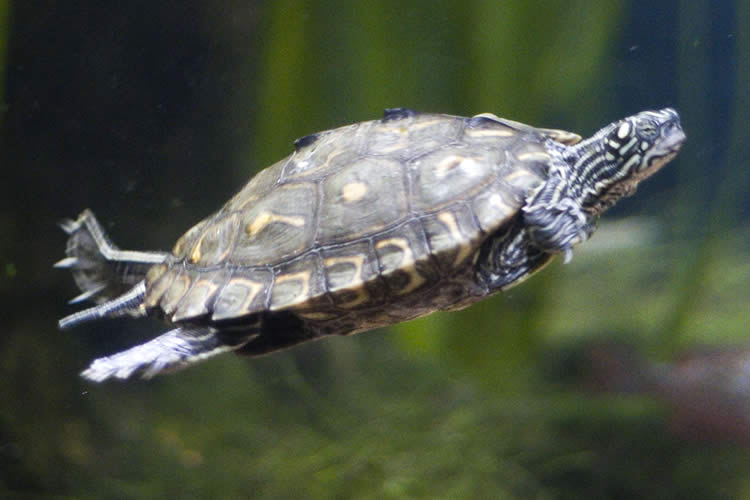A water turtle can stay out of water for several hours, but it depends on the species and environment. Water turtles should not be kept out of water for extended periods as they need water to survive.
Water turtles have adapted to spending time both in water and on land, so it’s important to provide them with a balance of both environments in their habitat. Understanding the specific needs of your water turtle and ensuring they have access to water when needed is crucial for their health and well-being.
By creating a suitable habitat with proper water and land areas, you can ensure that your water turtle remains healthy and happy.
The Natural Habitat Of Water Turtles
Water turtles are fascinating creatures that thrive in aquatic environments, showcasing remarkable adaptations and behaviors in the wild.
Adaptation To Aquatic Environments
Water turtles have evolved to live primarily in water, with streamlined bodies and webbed feet for efficient swimming.
Behavioral Patterns In The Wild
Water turtles exhibit various behaviors in their natural habitat, including basking in the sun on rocks and logs to regulate their body temperature.
Physical Characteristics Of Water Turtles
Water turtles, also known as aquatic turtles, are fascinating creatures with unique physical characteristics that enable them to thrive both in and out of water. Understanding their physical attributes is essential in comprehending how long they can stay out of water.
Shell Structure And Function
The shell of water turtles is a defining feature that provides protection and buoyancy. It consists of two main parts, the carapace (top shell) and the plastron (bottom shell), which are connected by a bridge of bone and cartilage. The shell not only shields the turtle’s internal organs from harm but also aids in regulating its body temperature. It serves as a crucial aspect of their physical makeup, allowing them to adapt to various environments.
Respiration And Oxygen Requirements
Water turtles possess specialized respiratory systems that enable them to extract oxygen from both water and air. While in water, they respire through their skin and the lining of their mouth, allowing them to absorb oxygen dissolved in the water. When on land, they rely on their lungs to breathe air. This dual respiratory ability is essential for their survival, allowing them to remain out of water for extended periods without compromising their oxygen requirements.
Survival Strategies Of Water Turtles
Water turtles have remarkable survival strategies that enable them to stay out of water for prolonged periods. Their ability to withstand dry conditions and conserve water allows them to stay out of water for weeks or even months, depending on the species and environmental factors.
Water turtles, also known as aquatic turtles, are known for their unique ability to live both in water and on land. These turtles have evolved several survival strategies to help them adapt to their environment and increase their chances of survival. In this article, we will explore two of the most important survival strategies of water turtles: estivation and burrowing behavior and their ability to conserve moisture.Estivation
Estivation is a survival strategy that helps water turtles survive in hot and dry environments. During estivation, water turtles bury themselves in the mud or sand, and slow down their metabolic rate to conserve energy. This allows them to survive for long periods without food or water. Estivation is similar to hibernation, but it occurs during the summer months when temperatures are high.Burrowing Behavior
Burrowing behavior is another survival strategy used by water turtles. This behavior involves digging burrows in the soil or sand, where they can retreat during periods of extreme heat or cold. Burrowing behavior is also used during hibernation and estivation.Ability To Conserve Moisture
Water turtles have a unique ability to conserve moisture, which is important for their survival in both aquatic and terrestrial environments. Their skin is covered in a layer of keratin, which helps to prevent water loss and protects them from drying out. Additionally, water turtles have the ability to recycle water from their urine, which helps them to conserve water in dry environments. In conclusion, water turtles have evolved several survival strategies to help them adapt to their environment and increase their chances of survival. Estivation and burrowing behavior are two important strategies that help water turtles survive in hot and dry environments. Additionally, their ability to conserve moisture is critical for their survival in both aquatic and terrestrial environments.Factors Affecting Time Spent Out Of Water
Factors affecting the time water turtles can spend out of water play a crucial role in understanding their behavior and care requirements. By examining the species variability and environmental conditions, we can gain valuable insights into the ability of water turtles to survive outside their aquatic habitat.
Species Variability
The duration a water turtle can remain out of water varies across different species. While some species, such as the painted turtle, can withstand extended periods on land, others, like the red-eared slider, may require more frequent access to water. Understanding the specific needs of the turtle species is essential for providing appropriate care and ensuring their well-being.
Environmental Conditions
The environmental conditions, including temperature, humidity, and access to shade, significantly impact the time a water turtle can spend out of water. High temperatures and low humidity levels can lead to dehydration and stress, limiting the duration of their terrestrial activity. Providing a suitable environment with optimal conditions is vital for promoting the health and longevity of water turtles outside of their aquatic habitat.
Implications For Pet Turtle Care
Understanding how long a water turtle can stay out of water is crucial for pet owners to provide a suitable habitat and proper care practices. This knowledge ensures the well-being and longevity of pet turtles.
Creating A Suitable Habitat
Adequate space with both water and dry land areas is essential for pet turtles. The tank or enclosure should be large enough to accommodate their size and allow for free movement. A basking area with a heat lamp and UVB light is necessary for maintaining their health.
Monitoring And Care Practices
- Regularly monitor the temperature and humidity levels within the habitat to ensure they are within the appropriate range for the specific turtle species.
- Provide a balanced diet consisting of commercial turtle pellets, vegetables, and occasional live food to meet their nutritional needs.
- Regularly clean the water and substrate to maintain a hygienic environment for the turtles.

Credit: www.reddit.com
Risks Of Prolonged Water Deprivation
Water turtles are aquatic creatures that require water to survive. While they can stay out of water for some time, prolonged water deprivation can be detrimental to their health. It is essential to understand the risks involved in keeping a water turtle out of the water for too long.
Health Consequences
Water turtles are prone to dehydration, which can have severe consequences on their health. Prolonged water deprivation can cause kidney failure, respiratory problems, and even death. Dehydration can also lead to the thickening of the blood, which can increase the risk of heart attack or stroke.
When a water turtle is out of the water for an extended period, it can also cause skin problems. The skin can become dry and flaky, leading to infections and other health issues. It can also cause shell rot, which is a bacterial infection that can cause the shell to deteriorate.
Behavioral Indicators
Water turtles are active creatures that love to swim and bask in the sun. When they are out of the water for too long, they can become lethargic and lose their appetite. They may also become more aggressive and irritable, which can be a sign of stress.
Another behavioral indicator that a water turtle is suffering from prolonged water deprivation is the curling of their limbs. When a water turtle curls its limbs, it is trying to conserve moisture in its body. This is a clear sign that the turtle needs to be returned to the water.
In conclusion, it is essential to ensure that water turtles have access to water at all times. Prolonged water deprivation can cause severe health problems and behavioral changes that can be detrimental to their wellbeing. As a responsible pet owner, it is your duty to provide your water turtle with a suitable environment that meets their needs.
Interaction With Humans
Water turtles have a unique and fascinating interaction with humans. Whether they are kept as pets, observed in the wild, or encountered in educational settings, these creatures capture the curiosity and attention of people of all ages.
Conservation Efforts
Conservation efforts play a crucial role in protecting the habitats and populations of water turtles. This involves preserving natural environments, implementing laws and regulations, and raising awareness about the importance of these species in the ecosystem.
Educational Outreach
Educational outreach initiatives are vital for spreading knowledge about water turtles. These programs aim to educate the public about the significance of these animals, their habitats, and the threats they face. By raising awareness, educational outreach contributes to the conservation of water turtles.
Credit: www.quora.com
Conclusion And Future Considerations
Conclusion and Future Considerations:
Understanding the duration a water turtle can stay out of water is crucial for their well-being. Let’s delve into the research opportunities and ethical considerations surrounding this topic.
Research Opportunities
Exploring the impact of extended periods out of water on water turtles’ health.
Ethical Considerations
Ensuring the welfare of water turtles when studying their behaviors and adaptations.
Credit: www.quora.com
Conclusion
Water turtles can survive out of water for hours but need water for health. Understanding their needs is crucial for their well-being. Providing a suitable environment is key to ensuring a happy and healthy water turtle. Remember, proper care and attention are essential for their longevity.






Leave a Reply